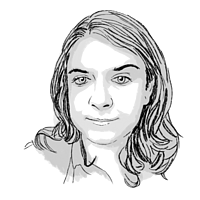In post-Assad Syria, a Ramadan embrace of freedom and solidarity
| Damascus, Syria
Alaa al-Saadi, like many Syrian men of his generation, once fought to overthrow longtime dictator Bashar al-Assad.
Now Mr. Saadi is savoring his first “free” Ramadan in his hometown of Qaboun, a low-income neighborhood and former rebel stronghold on the outskirts of Damascus.
At sunset, when Muslims rush home to break the fast with the iftar meal, the business owner stands on a street corner pouring out licorice juice from a giant metal pot.
“It’s all for the soul of the prophet Muhammad,” he explains, filling plastic bags with the deep purple liquid. “Licorice drink is very closely associated with Ramadan.”
Damascus is observing its first Ramadan since the fall of Mr. Assad, who cast himself as a protector of Syria’s many minorities while ruling them all with an iron fist. The Muslim holy month – one of heightened spirituality, and marked by the pursuit of good deeds to help those in need – is observed in Syria and across the Middle East.
Mr. Saadi, who spent several years in Libya before returning to Syria in 2019, recalls hiding during previous Ramadans to avoid being conscripted into the Syrian army.
Now, he is grateful to be in the position to help his community. His acts of generosity cost him $8 a day. The smiles of children in worn clothes are their own reward.
Families displaced by the conflict are trickling back to Qaboun, although much of it remains reduced to rubble after years of siege and bombardment.
“This Ramadan, our loved ones have returned,” says Mr. Saadi, fielding greetings outside his car-painting workshop. “We are reunited. Friends, loved ones, and young men are all back. Things will gradually improve.”
Indeed, Damascus seems to be inching toward greater functionality, with uniformed traffic police on the streets and a steadier electricity supply. The mood in the capital is one of cautious optimism under President Ahmed al-Sharaa, who broke ties with Al Qaeda and led the military effort that toppled Mr. Assad in December.
This has been a month of prayer but also mixed-gender celebrations that continue late into the night under the glitter of Ramadan light installations. Women in all kinds of Islamic dress – from the niqab to the veil – converged on central Ommayad Square for the March 15 marking of the anniversary of the 2011 Arab Spring-inspired revolution. So did women with no veil.
Most restaurants in the capital, a mixed-faith city, have been shut during daytime hours over Ramadan, but not all. Sundown has been marked by the distribution of dates, tamarind juice, and water bottles at busy street corners across the city.
There has been no shortage of individual and collective volunteer efforts inspired by the month of fasting.
In Douma, another war-ravaged suburb of Damascus, Osama Massaya leads the volunteer group Mulham. Boasting 40 participants, age 14 and up, it focuses on cleaning mosques and distributing meals to worshipers.
Such ideas are not new – but the possibility of executing them this freely is.
In 2024, Mr. Massaya, a history student at Damascus University, tried to obtain a license for a volunteer team to clean up mosques. The request never received the green light from the Ministry of the Endowment. “At the time, there was no interest in mosques,” he explains.
“The mosques were very neglected,” adds Mr. Massaya, whose team has helped to clean up a handful in Douma already. “The imams and servants of mosques were not paid. A teacher in a regular school had a salary, while a teacher giving religious lessons in a mosque received nothing.”
The Mulham volunteers aim to distribute 4,000 meals throughout Ramadan. Such efforts are financed by individual donations made by local residents, including some who resettled in Europe and the Middle East during the war and remain abroad.
Most donations – including a recent batch of 300 kilograms (660 pounds) of dates – are made anonymously.
“Before the fall of the regime, people did not flock to mosques in such numbers,” says Mr. Massaya. “They now feel comfortable. In one mosque before the liberation, there were three rows [of worshipers], equivalent to about 150 people. Now, there are five to six rows.”
The activities of mosques were closely monitored in the past. In 2011, they were a springboard for post-Friday prayer protests against the Syrian regime, and long were treated as potential hubs of dissent.
Rua, a university student in Damascus who gave only one name and whose father died in the notorious Sadnaya prison, reports a similar newfound sense of freedom.
“It’s the difference between day and night,” she says of this Ramadan, recalling past years when “people prayed quietly and left mosques quickly,” to avoid regime informants.
“People now come to the mosques and pray with a loud voice,” she says. “We hear Quranic verses on the streets, and that gives us joy.”






